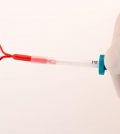- Study Suggests Earlier Is Better for Heart Valve Replacement Procedures
- Bird Flu Infection Confirmed in a Pig for First Time in U.S.
- Election Fears Are Keeping Americans Awake at Night, Survey Shows
- Most Patients Can Keep Using GLP-1 Weight Loss Meds Before Surgeries
- When This Black Cat Crossed His Path, It Was a Lucky Day for Medicine
- Staying In: Did Pandemic Shift Americans’ Leisure-Time Habits Permanently?
- Costs for MS, Parkinson’s and Alzheimer’s Meds Keep Rising
- With Cases Rising, What You Need to Know About Whooping Cough
- Halloween Candy: Don’t Get Spooked by All That Sugar
- Check Your Cabinet: Some COVID Test Expiration Dates Have Been Extended, FDA Says
Cervical Cancer Can Be Prevented: FDA

Although cervical cancer claims the lives of an estimated 4,000 American women every year, the disease is largely preventable, according to the U.S. Food and Drug Administration.
What’s more, if the disease is diagnosed early, cervical cancer is often curable, the agency said.
“If cervical cancer is found early, it’s easier to treat,” Shyam Kalavar, an expert in the microscopic examination of cells for the FDA, explained in an agency news release.
“It’s important to understand, however, that cervical cancer is also preventable. There are three FDA-approved vaccines that protect against the disease,” Kalavar added.
Cervical cancer forms in the cervix, or the lower part of the uterus that connects to the vagina. Human papillomavirus (HPV) causes cervical cancer, the FDA said, but not everyone who has HPV develops cervical cancer.
Cervical cancer often doesn’t cause symptoms, but can be detected during routine Pap tests, also called a Pap smear. The Pap test involves cells taken from the cervix. These cells are examined in a lab for signs of abnormalities that could lead to cancer, Kalavar said.
Pap smears are not 100 percent accurate and a small number of cancers may be overlooked in any one test, but it takes several years for cervical cancer to develop from abnormal cells. The FDA pointed out that by having routine Pap smears, changes in cervical cells can be detected early enough for women to receive the treatment they need.
Women with an abnormal Pap smear must undergo more testing for cervical cancer, which may include an HPV test. Having both tests reduces the likelihood that abnormal cells are missed, the agency said.
There are more than 100 different types of HPV, the FDA said. Some of these viruses aren’t harmful. The HPV test checks for the presence of the types of HPV most likely to cause cancer. Some women may also need to have a biopsy of their cervix, the FDA noted.
The HPV vaccines don’t help treat cervical cancer, but they are all effective in protecting against the two types of HPV that cause about 70 percent of cervical cancers, according to the FDA. One vaccine — Gardasil 9 — also offers protection against five additional HPV types that cause about 20 percent of cervical cancers. People must be vaccinated before being infected with HPV to be fully protected, the FDA said.
“These vaccines are preventative and work like other vaccines that prevent diseases caused by viruses and bacteria: they prompt the body to produce antibodies to protect against infection,” Marion Gruber, director of the FDA’s Office of Vaccines Research and Review, said in the news release.
“Women, including those who have been vaccinated, should continue to get Pap tests because they are essential to detect cervical cancer and precancerous changes,” Gruber said.
More information
The American Cancer Society provides more information on cervical cancer.
Source: HealthDay
Copyright © 2024 HealthDay. All rights reserved.










